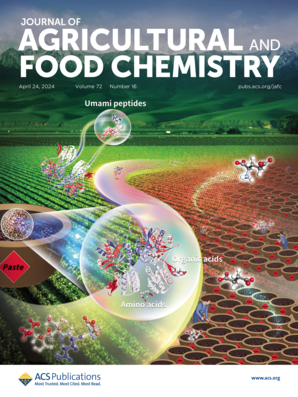Comparative Study of Three Diverse Glycogen Branching Enzymes for Efficient Generation of Highly Surface Branched Starch Granules with Enhanced Digestive Resistance
IF 5.7
1区 农林科学
Q1 AGRICULTURE, MULTIDISCIPLINARY
引用次数: 0
Abstract
Glycogen branching enzymes (GBEs) are widely applied to functionalize starch. However, modification of granular starch is challenging, and among GBEs, so far, only GBEs from Geobacillus thermoglucosidans (GtGBE) and Rhodothermus obamensis (RoGBE) have been used. To further develop their modification, starch granules of waxy, normal, and three types of high-amylose maize starches were treated with GBEs from Petrotoga mobilis (PmGBE), Rhodothermus marinus (RmGBE), and RoGBE as a benchmark. PmBE most effectively and rapidly added short branches, causing a reduced crystallinity and surface order of the starch granules. Furthermore, digestibility analysis indicated that PmGBE boosted the content of resistant starch. Along with its high activity, PmGBE showed a superior binding capacity to starch granules. Based on structural comparison, surface binding sites and the N-terminal domain of unknown function in PmGBE are proposed to influence activity and substrate specificity. Thus, PmGBE showed potential as an effective tool for the future modification of starch granules.

三种不同糖原分支酶高效生成高表面支化淀粉颗粒的比较研究
糖原分支酶在淀粉功能化方面有着广泛的应用。然而,颗粒淀粉的改性是具有挑战性的,到目前为止,在GBEs中,只有来自热葡萄糖苷地杆菌(GtGBE)和奥巴马红热杆菌(RoGBE)的GBEs被使用。为进一步研究蜡质淀粉、普通淀粉和3种高直链淀粉淀粉颗粒的改性,以Petrotoga mobilis (PmGBE)、Rhodothermus marinus (RmGBE)和RoGBE为基准,对其进行了改性处理。PmBE最有效和快速地添加短分支,导致淀粉颗粒的结晶度和表面秩序降低。此外,消化率分析表明,PmGBE提高了抗性淀粉的含量。PmGBE具有较高的活性,对淀粉颗粒具有较强的结合能力。基于结构比较,提出PmGBE的表面结合位点和未知功能的n端结构域会影响活性和底物特异性。因此,PmGBE显示出作为未来淀粉颗粒改性的有效工具的潜力。
本文章由计算机程序翻译,如有差异,请以英文原文为准。
求助全文
约1分钟内获得全文
求助全文
来源期刊
CiteScore
9.90
自引率
8.20%
发文量
1375
审稿时长
2.3 months
期刊介绍:
The Journal of Agricultural and Food Chemistry publishes high-quality, cutting edge original research representing complete studies and research advances dealing with the chemistry and biochemistry of agriculture and food. The Journal also encourages papers with chemistry and/or biochemistry as a major component combined with biological/sensory/nutritional/toxicological evaluation related to agriculture and/or food.

 求助内容:
求助内容: 应助结果提醒方式:
应助结果提醒方式:


